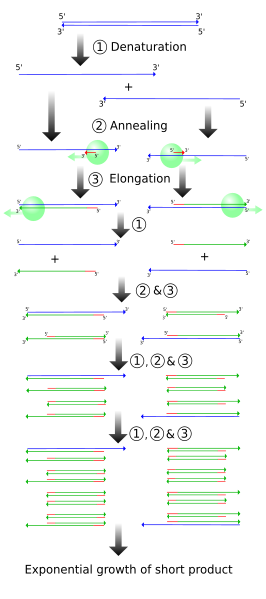 Daily Newsletter
Daily Newsletter
October 24, 2013 - PCR
Polymerase Chain Reaction
 In 1993, Kary Mullis won the Noble Prize in Chemistry for his work on the technology of Polymerase Chain Reaction (PCR). By using the basic mechanism of replication, PCR allows scientists to amplify a few DNA fragments (or even a single fragment) into thousands of identical copies (you increase your number of identical copies 3-5 orders of magnitude).
In 1993, Kary Mullis won the Noble Prize in Chemistry for his work on the technology of Polymerase Chain Reaction (PCR). By using the basic mechanism of replication, PCR allows scientists to amplify a few DNA fragments (or even a single fragment) into thousands of identical copies (you increase your number of identical copies 3-5 orders of magnitude).PCR uses thermal cycles (regular changes in temperature that are repeated multiple times) to denature DNA, anneal primers, and replicate. Primers? Remember that you must have primers for DNA polymerase to work. In this case, we provide primers that are complementary to segments of DNA that we want to copy (we provide both a 5'-3' and 3'-5' primer so we can get both strands). So the selection of primers is a critical feature to PCR work.
Notice, we are also using thermal cycles. Can we use just any DNA polymerase? No. We have to use a heat stable polymerase. For PCR, we use Taq Polymerase, originally from the thermophillic bacterium Thermus aquaticus. The Taq polymerase from Thermus aquaticus is not the most accurate, so people have been using thermostable polymerases from other prokaryotes. Question: How can a prokaryotic polymerase be used to replicate eukaryotic DNA? (Genetic Code is universal, and so are the molecules)
In the PCR process, DNA is denatured to single strands. Primers are annealed (complementary base paring) to the DNA strands. Taq polymerase then elongates until the cycle ends or your at the end of the template. You then repeat the process again and again.
Nice post. It is very interesting article. I really love this. Thank you for the sharing. Pcr test rapid test
ReplyDelete